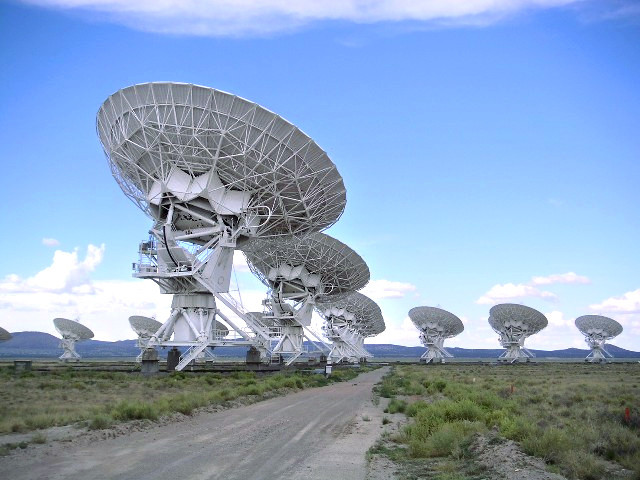


The Karl G. Jansky Very Large Array is a centimeter-wavelength radio astronomy observatory located in central New Mexico on the Plains of San Agustin, between the towns of Magdalena and Datil, ~50 miles west of Socorro.
The Very Large Array, one of the world's premier astronomical radio observatories, consists of 27 radio antennas in a Y-shaped configuration on the Plains of San Agustin fifty miles west of Socorro, New Mexico. Each antenna is 25 meters (82 feet) in diameter. The data from the antennas is combined electronically to give the resolution of an antenna 36 km (22 miles) across, with the equivalent sensitivity of a dish 130 meters (422 feet) in diameter.
Located in the middle of nowhere, it takes a bit of effort to get to the National Radio Astronomy Observatory Very Large Array (VLA). That said it’s definitely worth a detour if you find yourself tooling down Interstate 25, between Albuquerque and Las Cruces. This Plains of San Agustin site is actually the perfect location for a radio wave telescope, as it’s high, flat and far away from the man-made electrical interference found in the city. And despite its remote locale, the VLA offers good access for wheelchair-users and slow walkers.
Spread over more than 100 square-miles of New Mexico desert, the massive antennae that make up the VLA are located about an hour-drive west of Socorro. Take exit 150 from Interstate 25, then head west on Highway 60 for about 45 miles. After you pass Magdalena, go south on Highway 52 for about 3 miles. The VLA is on the right – trust me you can’t miss it.
There’s accessible parking in front of the visitor center, with barrier-free access to the building. Inside there’s a small gift shop and a few exhibits about the VLA. There’s also level access to the theater with plenty of room for a wheelchair next to the seats. Take some time to watch the excellent movie – narrated by Jodie Foster – that explains how the array works and what exactly it’s able to do.
The VLA is comprised of 27 dish shaped antennae arranged in a Y configuration across the desert. Each antenna is 82 feet in diameter, and combined they form a giant telescope that measures radio waves that come from stars, planets, galaxies and clouds of dust. When the data of the individual antennae are combined, it’s equivalent to using one giant antenna with a 22-mile diameter.
And because of that resolution astronomers are able to study remote galaxies, such as Heinze 2-10, which is located 30 million light years from Earth. They are also able to get a detailed look at galaxies and black hole formations that were created in the early universe, and compare them to what’s happening now. It’s truly one of the most powerful – and useful – astronomical tools available today.
Explore the Complex
Visitors can also get an up-close-and-personal look at the antennae, as well as a few other outside exhibits, from a short level trail that winds around the complex. Granted you can still get a good view of the VLA from the back of the visitor center — because it’s so massive — but the interpretive displays along the short walking tour are excellent.
The first stop on the walking tour is the Bracewell Radio Sundial, which is located near the back entrance to the visitor center. Named after Roy Bracewell, who created one of the world’s first radio telescopes, this sundial consists of a sphere mounted on a pole, and seven others mounted on cement pedestals. Like a traditional sundial, the sphere on the pole casts a downward shadow to markers on the cement, and depicts the time of day. The other spheres help radio astronomers locate three prominent stellar objects – Centaurus A, Cassiopeia A and Cygnus A – which act as stellar landmarks and enable them to locate other galaxies, stars and celestial bodies.
From the sundial, continue along the path past the Whisper Dish Gallery, and head over to the Radio Dish Gallery, which is located in the gazebo near the antennae. After that, make a left and head out to the base of the closest antenna, where there’s another interpretive plaque that describes its workings. Standing next to the 230-ton antenna is rather intimidating, and downright spooky if it repositions itself while you are there.
The walking tour continues to the second-story balcony of the control building, where visitors can get a panoramic view of the array. Unfortunately the only way to access the balcony is by a standard staircase, so it’s not an option for wheelchair-users or anyone who can’t climb 24 stairs. To be honest though, you can get a good view of the VLA from just about anywhere in the complex, so the inaccessible balcony doesn’t really detract from the experience. Finally, don’t forget to stop at the antenna assembly building on your drive out. Although you can’t go inside, it’s interesting to see how the antennae were assembled and installed.
The VLA makes a fun New Mexico road trip stop even if you aren’t an astronomy buff, as the silhouette of the array against the vast desert backdrop is worth the short detour alone. And amateur astronomers will absolutely love the site.

